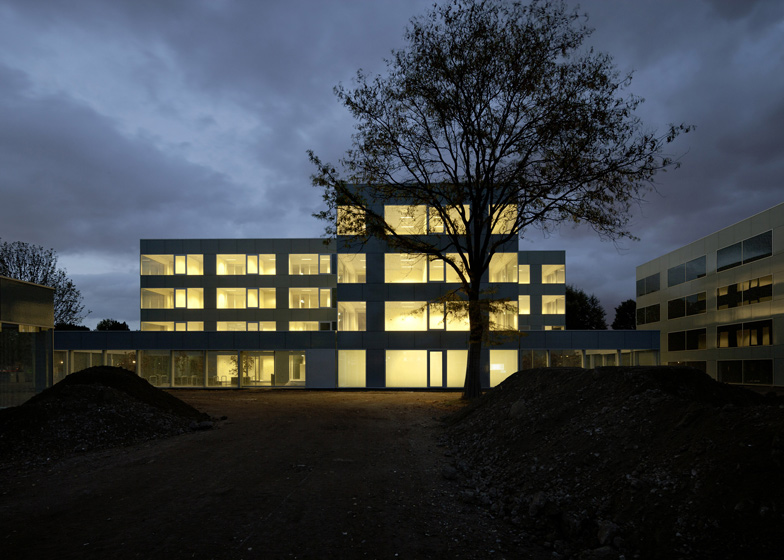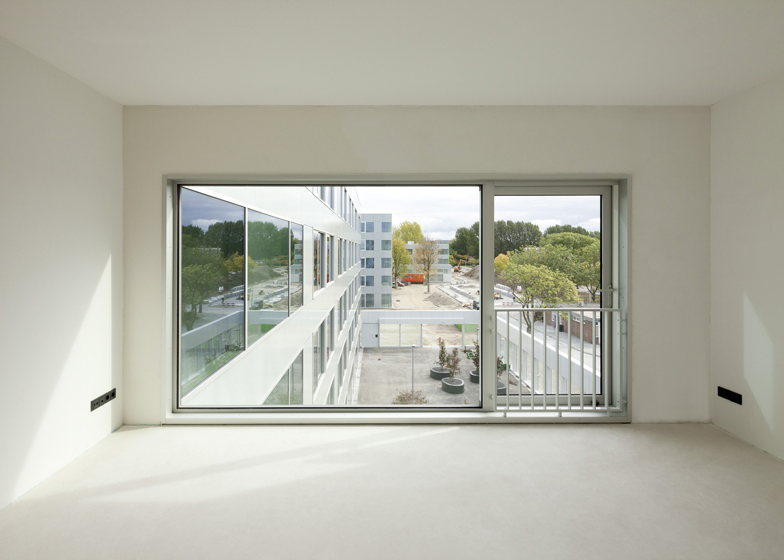Dutch firm Wiel Arets Architects has completed an academic campus in Rotterdam's Hoogvliet district comprising six concrete and glass buildings with subtle surface patterns designed to resemble ivy (+ slideshow).
Wiel Arets Architects used fritted glass and textured concrete to suggest traces of climbing plants on the pared-down walls and windows of Campus Hoogvliet - a school and college campus providing housing and teaching for students between the ages of 12 and 27 years.
All six buildings sit over the asphalt ground surface that defines the limits of the campus. These include a sports centre, an arts school, a safety training academy, a secondary school, a business academy and a housing block for up to 100 residents.
A glass fence surrounds every building and is fritted with the abstracted ivy pattern to maintain privacy for students. The same motif also embellishes the ground floor windows of each building.
A scaled-up version of the pattern reoccurs within each of the buildings, where exposed concrete walls are broken up by stripy concrete reliefs.
Each building can be identified by a different colour, which can be spotted on the glass balustrades that run alongside each staircase, but they are otherwise all identical in materials and finishes.
"Unity defines the campus and its clustered buildings, which are therefore experienced as continuous architecture," said the architects.
The largest of the buildings is the sports centre that contains a 300-seat multi-purpose hall. The ground floor of this structure is raised up by a storey to make room for car parking, while an outdoor basketball court is located on the roof.
Custom-designed seating is dotted around the site, including white terrazzo benches and circular planters containing Japanese maple trees. There's also a running track, bicycle storage areas and a campus-wide lighting system that illuminates outdoor areas after dark.
Photography is by Jan Bitter.
Here's a project description from Wiel Arets Architects:
WAA complete construction on Campus Hoogvliet in Rotterdam
Campus Hoogvliet is a cluster of six buildings that together compose one academic and socially focused campus, located just outside of Rotterdam. These six new buildings - a sports centre, an art studio, a safety academy, 100 residential units within one building, and two schools - have been plugged into a programmed tarmac that communicates the campus' boundary, and includes custom-designed seating, a running track, and other place-making denotations.
The campus' immediate surroundings are characterised by mid-twentieth century housing developments - which were prolifically constructed during its booming period of post-WWII growth - and the campus aims to rectify the social and cultural deterioration that coupled the demolition of this once historic village.
A glass 'fence' - equal in height to each ground floor facade - surrounds every building. Every fence is fritted with an abstracted, pixilated image of ivy, so as to create an exterior terrace that is both private and transparent. The ground floors of each building are fritted with the same pattern, and all exterior glass was made with a kiss print, which introduces texture to each facade.
A white ring surrounds every building and denotes the transition from public tarmac to private terrace, each programmed with bike parking and play areas. All six buildings share a similar procession of entry: spaces compress in volume when transitioning from the campus' tarmac toward the glass-fenced terraces; decompress when entering each building's ground floor communal spaces; and compress again when traversing circulation paths toward upper levels.
The sports centre's tribune seats 300 and overlooks its multi-purpose and double height activity space, which functions as an exercise area for students and is also available for local events and sports teams. This sports centre - the largest of the campus' six buildings - has been raised one level in order to accommodate a 80 space parking garage on its ground floor; this introduces a 'zero-zero' level to the campus, which compounds the notion of 'interiority'. Additional parking for 200 aligns with and compliments the campus's boundary, so as to not disturb its highly trafficked pedestrian areas. An outdoor basketball court occupies the roof of the sports centre's ground floor; it is perpendicular to a monumental staircase that allows for views over the sprawling campus below.
Load-bearing facades with open corners - combined with concrete cores for stability, and non-polished concrete floor slabs under tension - structure each building. Cores are notable for their concrete relief, derived from an enlarged pattern of the fritted ivy, adjacent to which are each building's shifting sets of staircases. Balustrades are finished with coloured glass, and each building has a unique colour, to impart a visual identity within each.
Custom-designed white terrazzo seating dots the campus' programmed tarmac, and Japanese Maples set in custom-designed black terrazzo planters dot each fenced terrace. The entirety of the programmed tarmac, and every terrace, are illuminated at night to ensure the surrounding community's cohesiveness. Unity defines the campus and its clustered buildings, which are therefore experienced as continuous architecture.
Location: Lengweg, 3192 BM Rotterdam, The Netherlands
Typology: Educational, Housing, Retail, School, Sport
Size: 41.100 m2
Date of design: 2007-2009
Date of completion: 2014
Project team: Wiel Arets, Bettina Kraus, Joris van den Hoogen, Jos Beekhuijzen, Mai Henriksen
Collaborators: Jochem Homminga, Joost Korver, Marie Morin, Julius Klatte, Olivier Brinckman, Sjoerd Wilbers, Raymond van Sabben, Benine Dekker, Maron Vondeling, Anne-Marie Diderich
Client: Woonbron
Consultants: ABT BV, Wetering Raadgevende Ingenieurs BV

















